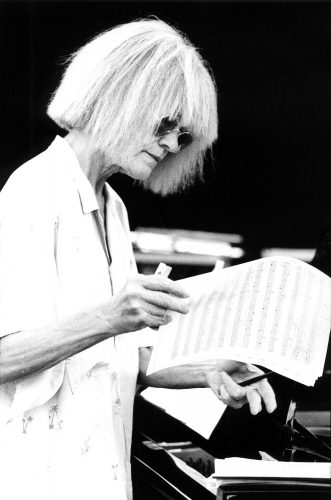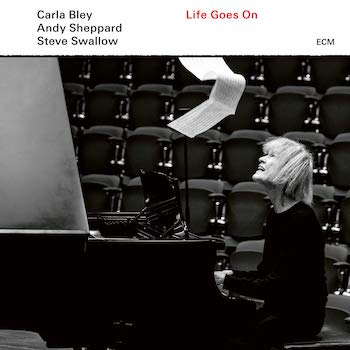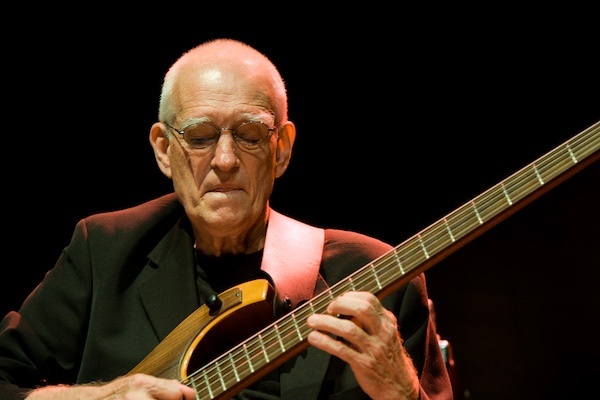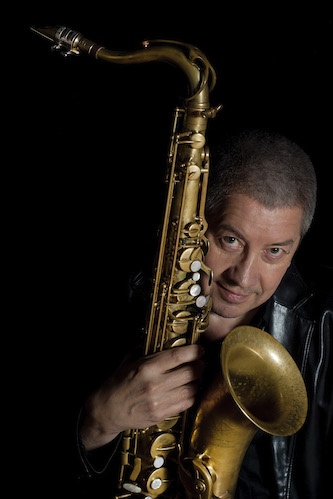Jazz Appreciation/Album Review — Carla Bley, 84 and Counting
By Steve Elman
Carla Bley’s last three CDs are not a casual sequence, and hearing all of them together, as I did recently, provides a refreshing reminder of her greatness.
It is no shame to love Carla Bley’s music.

Carla Bley — one of the greatest living jazz composers. Photo: ECM
Some people seem to think that admiring Bley and listening raptly to her recordings are guilty pleasures. She is not a flashy pianist — in fact, some of her solos sound prewritten. She likes to be funny in a puckish, not-at-all-jazzy way. Her bands have, at times, been like traveling vaudeville troupes. She is not afraid of schmaltz, although she often adds lemon juice to it. In big formats, she has been grandiose, usually ironically, although she is capable of suddenly transforming grandiosity to intimacy. In minimalist formats, like the trio with which she has been making most of her recent recordings, she and her mates can be so laconic as to make Thelonious Monk’s groups seem wordy.
She is not Serious, as in “self-important.” But she is very serious, as in “true to an artistic vision.”
She is one of the greatest living jazz composers. She is not the only one, especially in these days of talent aplenty, but she is too often overshadowed, and that is something of a shame.
Yes, there is Maria Schneider, five-time Grammy winner (and a nominee again this year). She’s won the hat trick of Best Composer, Best Arranger, and Best Big Band seven times in the last 10 DownBeat Critics’ Polls, and in 2013, she tied for that honor with Darcy James Argue, another name to reckon with.
There is Wayne Shorter, whose body of short-form compositions is a Real Book in itself for aspiring players, and who has ambitiously expanded a personal universe-view into long-form work.
There are Anthony Davis and and Henry Threadgill, winners of the Pulitzer Prize for Music (both unwilling to crowbar themselves into the frame of “jazz”). And there are Don Byron, Wadada Leo Smith, and John Zorn, who were finalists for same. And Wynton Marsalis, who broke the genre line for the Pulitzers in 1997.
Not to mention Uri Caine, whose grand oratorio for jazz quartet, vocal soloist, chorus, and orchestra, “The Passion of Octavius Catto,” was to be premiered with the BSO in March 2020, Before Everything Changed.
Even in our own community, jazz composition thrives. Mark Harvey turns out new (often topical) work every year for the Aardvark Jazz Orchestra. Darrell Katz and his many colleagues soldier on with the Jazz Composers’ Alliance Orchestra (now 35 years old), offering new music in live showcases and CDs. Berklee and the New England Conservatory offer ambitious concerts at least once a year to spotlight ambitious, usually genre-defying, work by students and alumni.
And I haven’t yet mentioned Anthony Braxton, David Murray, Miguel Zenón, Dave Douglas, Vijay Iyer …
Bley is unlike any of the above. She stands apart, almost literally, living in upstate New York with Steve Swallow and emerging every once in a while to do an interview or to make a recording. She is 84, and will turn 85 on May 11, 2021. If you look at the DownBeat poll runners-up for “Best Jazz Composer,” she is usually there — sometimes way down the list, often below names who are much less significant. Perhaps she has been inoculated against attention by experiencing the flow and ebb of acclaim and indifference. In any case, she seems to have no ambition to be recognized as anything other than herself.

Her last three CDs, Trios (2012), Andando el tiempo (2017), and Life Goes On (2020) are her only recordings so far for ECM, although her private labels, WATT and XtraWATT, have had a long distribution partnership with the German parent company. The three are not a casual sequence. Hearing all of them together, as I did recently, provides a refreshing reminder of her greatness.
The correlation of the three is obvious. They were all recorded in Lugano, Switzerland. Each consists entirely of distinctive Bley originals, and each has at least one three-part suite of new music to savor. In each of them she works with her most intimate band so far, a drummerless trio with Andy Sheppard on tenor and soprano and Steve Swallow on electric bass. This minimalist format displays the lucidity of her thinking, and also allows us to hear her influences more clearly than we ever have been able to in her large-ensemble pieces.
Even the packages emphasize their fraternity. They all feature black-and-white cover photos by Caterina di Pierri of Bley at the piano, possibly from the same shoot. Trios shows her playing, seemingly deep in thought, face completely obscured by her hair. For Andando el tiempo, she is captured in a busy moment, unfolding pages of her sheet music like sails in the wind. The Life Goes On pic catches her smiling as the score for one of her compositions floats in the air, almost above her head.
Trios is a kind of “first movement,” a broad-brush introduction to the territory she wants to cover in this format, possibly prompted by her performance with this group at the Grenoble Jazz Festival in 2012. Andando el tiempo is the darkest recording she has ever made, anchored by a suite of pieces inspired by the struggle of an unnamed friend going from addiction to recovery. Life Goes On consists of three multipart suites, recorded well before our COVID purgatory, all in great good humor, sweet assurances in these uncertain times that her art is undiminished.
There isn’t a single performance on each of these three that doesn’t repay careful study, but as a way of demonstrating their breadth, let me sketch one work from each of them.
Anyone who appreciates Bley will know that Thelonious Monk is one of her important influences. He is everywhere in these three CDs, perhaps standing more obviously in the wings than he has ever before in her music. Trios has one of her most direct homages to him, a suite of pieces commissioned by the Grenoble Jazz Festival called “Les Trois Lagons (d’après Henri Matisse).”
Why did she decide to put Monk and Matisse together? They both stripped their art down to fundamental shapes and colors. They both delighted in bold statements and sharp contrasts that repay repeated appreciation. But it may just be that the commission gave Bley the chance to celebrate Monk in a big way.
The three parts of Lagons are named for untitled sequential plates (numbers 17 through 19) from vivid Matisse cutout prints published in his book called Jazz (1940). Matisse calls each a lagon (lagoon), and each features forms that suggest seaweed or aquatic plant life. I’ve provided Museum of Modern Art links to each print below, and they may be useful to see as you listen … or maybe not.
“Plate XVII” puts a strongly Monkish idea out front, in a structure like that of “Brilliant Corners.” The theme is stated slowly, punctuated with sudden stops. Then the tempo doubles into fast swing. Monk’s original idea in “Corners” required his group to carry a sense of forward motion through the tempo changes, which was especially difficult when the band had to downshift from fast to slow. Bley asks the same of her trio here, and she shows how well she learned from Monk’s example. She adds to the challenge by bringing each chorus of her tune to a complete halt, and even the solo order works against continuity. After Andy Sheppard’s solo over the two tempi, Steve Swallow drops out and Bley goes on alone. She quotes “Jeepers Creepers,” which may be a clue to the chord structure, but then moves into an unusually atonal statement, leaving swing feel behind. Even so, what she plays has a very logical structure, and the returns of bass and sax, and of her theme, make perfect sense of what she has just played.
“Plate XVIII” is another Monkish line, this one in his slow-ballad feel, like “Crepuscule with Nellie.” She gives the melody to Swallow, feeding him a few chords. Then Sheppard joins on tenor, reinforcing the roots of the chords, as Swallow solos lyrically, mostly in his upper register. Sheppard has a short solo, but it’s Swallow’s improv that stays with you.
“Plate XIX” starts with Bley playing some pseudo-stride, a style she has rarely used previously — but Monk does just this sort of thing occasionally in his solo pieces. Then the suite takes a sharp turn down a dark hallway. There is a long sudden silence, followed by dark piano chords, like horror-movie steps on the stairs, misterioso but more out of tonality — something akin to the work of Ran Blake, another pianist who owes a lot to Monk. Gradually, Bley eases some forward motion into her solo and brings back the stride. The group briefly hints at a slowish medium tempo, but then that disappears, and the suite ends with a dark coda.

Carla Bley. Photo: Caterina di Perri/ECM
Bley explains the sobering severity of the title suite from Andando el tiempo in the notes to the CD: “The three parts … represent stages of recovery from addiction…. It was written as I watched a friend go through the condition and come out the other end.” As interesting as this piece is, I think it wears its meaning on its sleeve. So, instead of going deep on that one, I’d like to look at the composition that closes the second CD, “Naked Bridges / Diving Brides.”
Bley describes this work in her notes: The title … refers to Peking Window, a poem by [neo-beat poet] Paul Haines…. I wrote it, with a little help from Felix Mendelssohn, as a wedding present for Andy Sheppard and his new bride, Sara.”
This description suggests a whimsical spin on the inevitable wedding march from Mendelssohn’s incidental music to A Midsummer Night’s Dream, but what Bley has assembled is a trousseau of a very different color.
Stately dissonant chords begin it, like tentative steps down the aisle of a darkened church. Then Bley sets up a merry-go-roundish 6/8, but the chords are anything but jolly — this is a merry-go-round like the one in Hitchcock’s Strangers on a Train. Swallow eases into a loping tempo and Sheppard solos seriously on soprano. The mood stays dark for almost three minutes, but then the harmonies shift a bit for Bley’s solo. She gives herself a bluesily ambiguous foundation, and calls for Sheppard to provide some long notes to accompany the piano.
She then slows the tempo down to a near halt for her statement of Mendelssohn’s wedding march, reharmonized and a bit Monkified. She adds dark augmentations on every chord that Mendelssohn used to provide uplift, and the result is something like a word of warning, or even a dark joke on the betrothed. But this ushers in Swallow’s lovely high-register bass solo, a beautiful contrast to everything that has gone before, with Bley providing her sweetest chords under it. Swallow concludes with a little wedding march quote, and then the darkness returns.
Sheppard comes back in on soprano sax, and the dissonant 6/8 merry-go-round begins spinning again. Sheppard’s second solo is more yearning and spiritual than his first one, but the harmonies under him never lighten. The out-of-tempo coda is Ran-Blake noir, including some down-stepping figures that don’t sound anything like a triumphant recessional.
I wonder what Sara Sheppard made of this wedding gift.
 The current CD, Life Goes On, comes as a bright contrast to Andando el tiempo, which doesn’t mean the music is any less significant. The title suite is rich with blues, Monk, and echt Bley, but I want to examine “Beautiful Telephones” in detail, because of its resonances with the music of Kurt Weill.
The current CD, Life Goes On, comes as a bright contrast to Andando el tiempo, which doesn’t mean the music is any less significant. The title suite is rich with blues, Monk, and echt Bley, but I want to examine “Beautiful Telephones” in detail, because of its resonances with the music of Kurt Weill.
Bley commented on Weill’s supposed influence on her music in an October 2000 AllAboutJazz feature by Craig Jolley (“Meet Carla Bley”):
“People have … asked me about Kurt Weill. I never heard Kurt Weill until after I moved to New York. [The Kurt Weill – Bertolt Brecht opera The Rise and Fall of the City of] Mahagonny was playing at the Public Theatre. I think I was thirty-two or thirty-three [c. 1968], well after I was supposedly influenced by him. I was [more deeply] influenced by Eric Satie. Maybe that’s what some people hear.”
But what she shares with Weill in the first part of “Beautiful Telephones” is stagy drama, ironic darkness, and a sense that dread (or sarcasm) may be waiting around the corner. There is also a sense of ritual that looks far back to her suite, “A Genuine Tong Funeral.” No one else in contemporary composition, no matter what the genre, does this as well as Bley.
The second part maintains this emotional ambiguity, with just a hint more rhythm, to underpin a sharp Sheppard tenor saxophone solo.
The third part adds a loping rhythm from Swallow, at first in the same dark feel, but including some major-key twists and hints of old-standard melody that’ll make you laugh if you understand the jokes. (The first tune quoted is “I’ve Been Working on the Railroad.”) Bley’s solo in this section has some direct references to Monk; there are even a couple of spots where it sounds like her fingering is slipping — but this may very well be intentional, just as all of Monk’s “wrong” fingering was. The closing ensemble has a strong gospel reference, and a long example of her trademark “question mark” codas, with a couple of false endings.
As I listened to these three CDs, I was struck by the same kind of realization that I had while listening to the works of Duke Ellington, Thelonious Monk, Charles Mingus, and George Russell, all of whom I was lucky enough to experience while they were living: It is a profound honor when great composers share their work with us, and we should be grateful for every minute we have with them.
Viva Carla.
More:
There were far too many asides in the original drafts of this piece, but for those interested in drilling down, I’ve put most of them here.
The title of Andando el tiempo might be translated as “the passage of time,” “passing the time,” “Let’s go – it’s time,” or even “walking in tempo.” It seems to be appropriate no matter how it’s translated.
The four lines of Paul Haines’s poem Peking Window that inspired the title “Naked Bridges / Diving Brides” are quoted in Andando el tiempo‘s liner notes — From naked bridges / Diving brides relax / In freefall fistfuls / Of sparkling albumen.
More great music from Bley:
I recommend all three of the CDs I spotlight here, but not in preference to any of her others. All three are hearable on Spotify, but I believe you should support her work by buying them. I have never regretted buying a Carla Bley CD.
Here are more gems to explore, also hearable on Spotify:
The three recent CDs had prequels.
Songs with Legs (WATT, 1994, now out of print, but hearable on Spotify) introduced this trio in a live date that included three of Bley’s familiar pieces — “Real Life Hits,” “The Lord is Listenin’ to Ya, Hallelujah,” and “Wrong Key Donkey,” plus a straightforward, (mostly) good-humored reading of Monk’s “Misterioso,” augmented only by an introductory section that only Bley could write and a beautifully reharmonized outchorus.
The Lost Chords (WATT, 2004) added Billy Drummond on percussion to the trio, and it included Bley’s wonderful three-part suite built on “Three Blind Mice,” plus a version of “Hip Hop,” a bouncy tune that has nothing to do with contemporary Black music.
There are four other intimate Bley CDs, duet sessions with Steve Swallow:
Night-glo (WATT, 1985)
Duets (WATT, 1988)
Go Together (WATT, 1994)
Are We There Yet? (WATT, 1999)
If you’re looking to explore even more of Bley’s discography, consult the blog created by Worcester-based music journalist Tyran Grillo, ECM: Between Sound and Space. Grillo has taken it upon himself to provide notes about nearly every release on ECM — not in a critical-review way, but informationally and descriptively. Among the hundreds of his thumbnail sketches are notes on Bley’s work on WATT, XtraWATT, and ECM. You’ll also find his approach useful in investigating releases by ECM unfamiliar artists, since the label has made it a practice to avoid traditional liner notes.

Bassist Steve Swallow. Photo: Wiki Common.
About Steve Swallow:
Swallow is such a monumental talent and such a profound original on his chosen instrument (electric bass) that any casual mention of him above would be an injustice, and even this squib is unfair to him. Suffice it to say that by now, Bley can’t write music without him. His voice is integral to the success of her pieces large and small. His eloquent solos are models of taste and style, and they always add new dimensions to Bley’s work.
But he is also an active composer in his own right, and Bley has recorded many of his tunes with him on their duet CDs (see above). Swallow classics like “Ladies in Mercedes,” “Eiderdown,” “Falling Grace,” and “Hullo Bolinas” have graced many of Gary Burton’s releases, and they have become staples for any musician who has passed through Berklee’s portals.
Speaking of which, John Scofield pays homage to his own Berklee heritage and to three of these great tunes on his most recent CD, Swallow Tales (ECM, 2020), which has drummer Bill Stewart and Swallow himself along for a delightful ride. Arts Fuse review

Saxophonist Andy Sheppard. Photo: Sara Da Costa
About Andy Sheppard:
Bley has worked with Sheppard for decades, in large contexts as well as this trio. He has a superior tone, neither too acid or too rich. He is a cogent thinker, and Bley must appreciate the fact that he matches his statements to her frames, never overstepping his bounds into look-what-I-can-do. He was one of George Russell’s favored soloists in the last years of that composer’s career. He has made some superior CDs of his own, including a fascinating experiment incorporating tabla into a small group (Movements in Colour, ECM, 2009)
About jazz composers other than Carla Bley:
So much good music, so little time. Surveying all of the current jazz composers I mention above would turn this post into a book, but I must add four postscripts:
Anyone who does not know Maria Schneider’s work should click over to a comprehensive career review by my Fuse colleague Allen Michie, prompted by her acclaimed new CD, Data Lords.
Mark Harvey has been very active this year, despite the pandemic. In his latest CD with Aardvark (Faces of Souls, Leo, 2020) he seeks, as he often does, to find meaning in current events, and he also presents two inspiring pieces reflecting on the Saint-Gaudens memorial sculpture on Boston Common. His most recent release (A Rite for All Souls, American Musicworks, 2020) is the opposite face of his work, a completely-improvised “aural theatre” piece performed in 1971 by The Mark Harvey Group, documenting one of the most ambitious avant-garde groups of the time in Boston, and memorializing the contributions of reed player Peter Bloom and two percussionists who have since passed away, Craig Ellis and Michael Standish. In addition, Harvey has presented Zoom showcases for and discussions about his work, expertly hosted by critic Bob Blumenthal.
The newest JCA (Jazz Composers Alliance) Orchestra CD (Live at the BPC, JCA Recordings, 2020) is a sharply designed, beautifully recorded set from a Berklee concert, with almost half the music devoted to terrific works by the wife-and-husband combination of Mimi Rabson and David Harris, plus music by founding father Darrell Katz and the remarkable trombonist Bob Pilkington. I’ll have more to say about Rabson in another post.
To hear music by some up-and-coming jazz composers from the New England Conservatory, you can stream a free live concert by the NEC Jazz Composers’ Workshop Orchestra on Tuesday, December 8 at 8 p.m. The orchestra is directed by Frank Carlberg, and the program includes Carlberg’s own “Brake Tune,” along with works by George Behrakis, Joseph Borsellino III, Hunter McKay, and Harrison Pershing. Borsellino and McKay are both saxophonists who will play in the orchestra on December 8, and McKay is the group’s assistant director. Here is the link for the streaming connection.
About Bley herself, here’s some very informative online material that was helpful to my thinking:
A 1974 John S. Wilson profile in the New York Times offers some revealing personal information.
An October 2000 AllAboutJazz feature by Craig Jolley (“Meet Carla Bley”) has quick takes by the artist on many of her works and influences, although Jolley misspells the name of Charles Wuorinen, whom Bley calls “My favorite composer now.” (Wuorinen passed away in March of this year. Boston Modern Orchestra production just released a recording of his 2004 opera, Haroun and the Sea of Stories.)
Pianist Ethan Iverson, a great appreciator of Bley’s work, interviewed her in January 2018 for his own website.
Iverson profiled her for The New Yorker in May 2018.
In 2003 Frank J. Oteri interviewed her for his blog, newmusicbox.
Steve Elman’s more than four decades in New England public radio have included ten years as a jazz host in the 1970s, five years as a classical host on WBUR in the 1980s, a short stint as senior producer of an arts magazine, 13 years as assistant general manager of WBUR, and fill-in classical host on 99.5 WCRB.

I loved your beautiful tribute to Bley’s recent work. Bravo.
And I love your terrific book on Bley’s work. I just wish it could have been 5 times as long – or more!
I’ve been inhabiting her 60-year recorded output for almost 50 years, most often on autorepeat. It’s delicious and nutritious, addictive and entrancing.
I was fascinated when I heard she loves Wuorinen’s music. Like his compatriot Elliott Carter, I hope she continues in strength to write vivid music to age 100 and beyond!
Fine trio of CDs. Can’t understand why “Life Goes On” isn’t on more “best of ” lists this year. In my estimation, it is very worthy.
Thanks for the review of Carla Bley’s more recent work. It doesn’t fit in with your theme, but I still think Escalator Over The Hill should be mentioned at all times. I continue to be surprised when even prominent jazz musicians and other music folks I meet have not heard of EOTH! Thanks again.